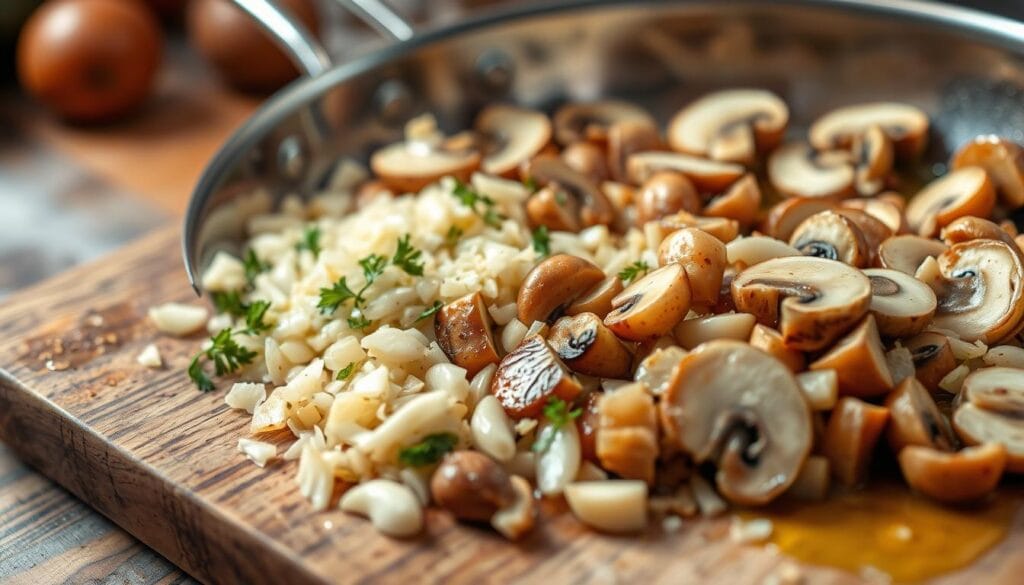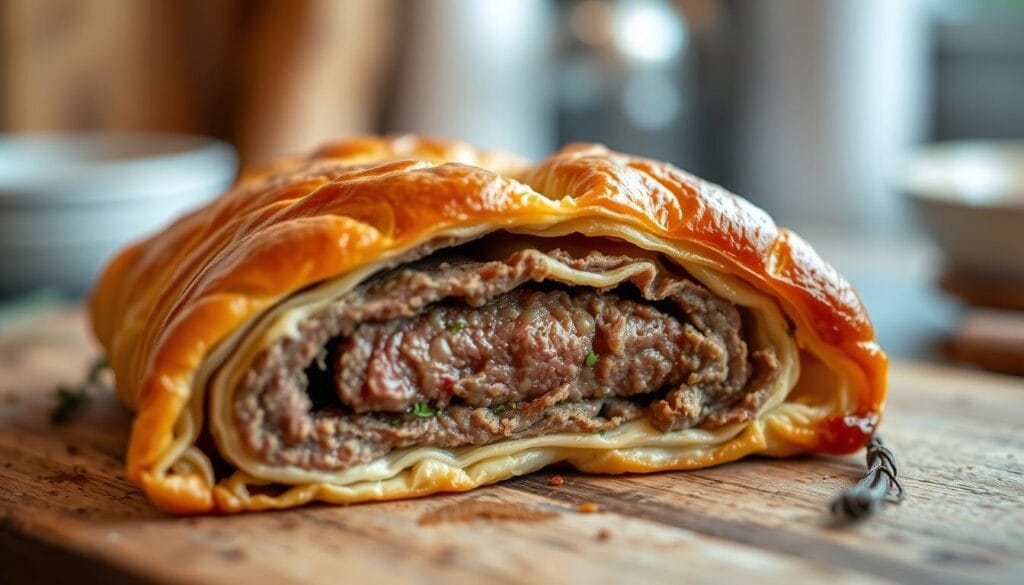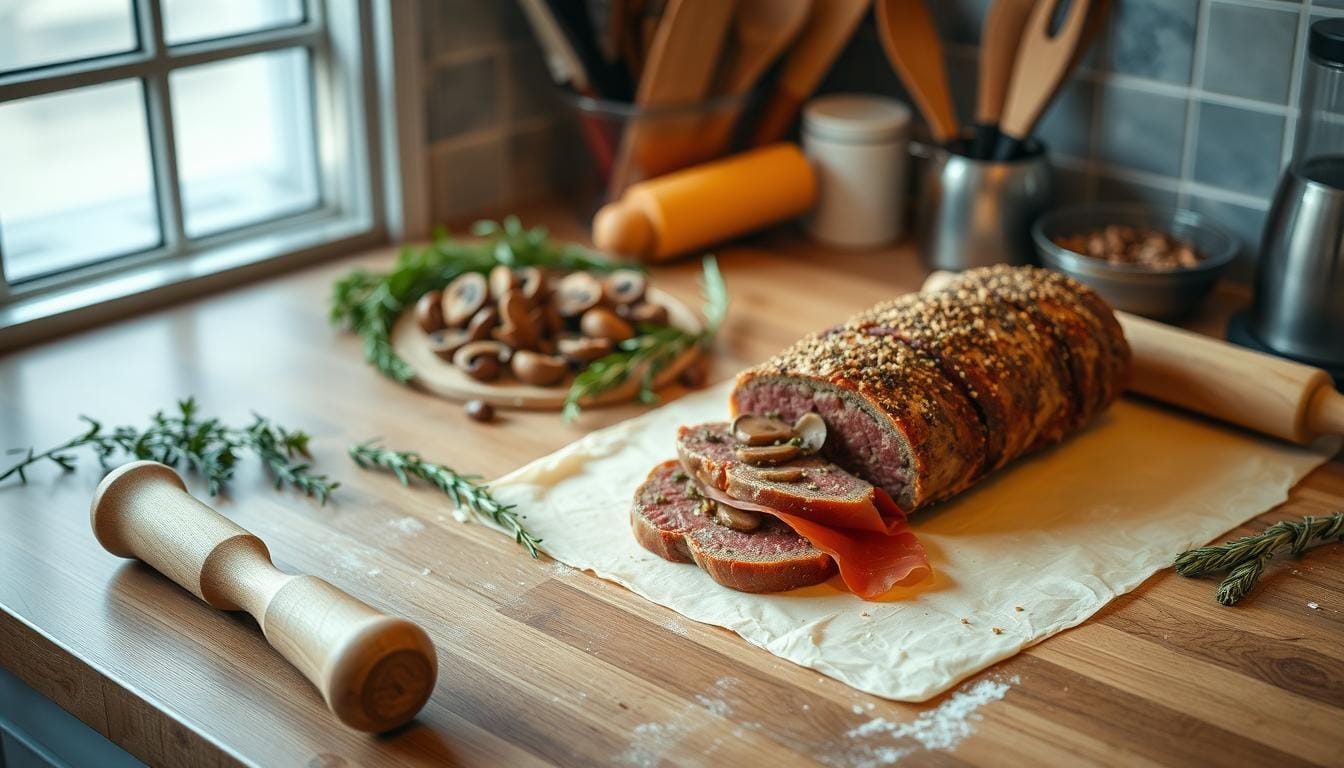Imagine a crisp winter evening with family around the table. A golden Beef Wellington is the star of the show. Making this dish might seem hard, but with the right steps, you’ll become a master chef.
The Beef Wellington recipe is more than food. It’s a journey of technique, precision, and passion. Both pros and home cooks love this dish for its elegance and ability to make any event special.
Making a perfect Beef Wellington needs patience, skill, and detail. Choosing the best beef tenderloin and making the mushroom duxelles are key. Each step is important for a dish that looks great and tastes amazing.
Table of Contents
Key Takeaways
- Beef Wellington is a sophisticated dish that can be mastered with practice
- Proper ingredient selection is crucial for success
- Technique matters more than complex skills
- Preparation can be done in stages to reduce stress
- The dish is perfect for impressing guests at special events
Understanding Beef Wellington’s Origins and Appeal
Explore the world of classic beef wellington, a dish that mixes British tradition with gourmet flair. It’s more than a meal; it’s a trip through culinary history that excites food lovers everywhere.
The tale of Beef Wellington starts in the early 19th century, rooted in British cooking. Named after the Duke of Wellington, it became a sign of sophistication and grace.
The British Culinary Heritage
Beef Wellington is the top of British cooking innovation. It comes from a mix of French techniques and British ingredients. This dish is:
- A perfect blend of continental and British culinary traditions
- Sophisticated cooking method combining multiple techniques
- A testament to culinary craftsmanship
Why It’s a Special Occasion Dish
An impressive beef wellington is more than a meal; it’s an event. Its complex preparation and luxurious ingredients make it perfect for:
- Celebratory dinners
- High-end restaurant menus
- Milestone events
“Beef Wellington represents the pinnacle of culinary artistry, transforming simple ingredients into an extraordinary dining experience.”
Modern Interpretations
Today, chefs are reimagining classic beef wellington with new twists. They use everything from molecular gastronomy to local ingredients. This keeps the dish a creative space for chefs.
Whether you’re cooking at home or in a professional kitchen, mastering Beef Wellington connects you to a rich culinary tradition.
Essential Ingredients for Your Beef Wellington
To make a stunning homemade beef Wellington, you need top-notch ingredients. These elements must work together perfectly. This is what turns a simple dish into a memorable meal.
The main ingredients of beef Wellington create a mix of tastes and textures. Let’s look at what’s key:
- Beef Tenderloin: The main attraction, needing the best meat
- Puff Pastry: Gives a golden, flaky outside
- Mushroom Duxelles: Brings in deep, savory flavors
- Prosciutto: Helps keep the meat moist
“Great ingredients are the foundation of an exceptional Beef Wellington” – Professional Chef’s Insight
Choosing the right ingredients is crucial for your beef Wellington. Here are important things to think about when you shop:
| Ingredient | Quality Indicators | Recommended Quantity |
|---|---|---|
| Beef Tenderloin | Bright red color, firm texture | 8 ounces per serving |
| Puff Pastry | Fresh, not frozen too long | 17.25 ounces package |
| Mushrooms | Brown, firm, no soft spots | 10 large mushrooms |
| Prosciutto | Thin, uniform slices | 2-3 slices per serving |
Being precise is key. Your ingredients should be fresh, of high quality, and handled with care. The right mix will make your dish go from good to amazing.
Selecting the Perfect Cut of Beef Tenderloin
Creating the best Beef Wellington starts with picking the right beef tenderloin. This top cut is the core of your dish. Knowing its details can make your Beef Wellington stand out.
The tenderloin muscle is known for its tenderness. It’s the best choice for Beef Wellington. Its low fat and round shape help it cook evenly and look great.
Quality Indicators for Premium Beef
When picking your tenderloin, look for these important signs:
- Color: Deep red with minimal brown spots
- Grade: Aim for Prime or Choice beef grades
- Marbling: Fine, consistent white fat distribution
- Texture: Smooth and firm to the touch
Size and Thickness Guidelines
For the best Beef Wellington, follow these guidelines:
- Weight: 2-2.5 pounds ideal for most recipes
- Thickness: At least 1¾ inches to prevent overcooking
- Length: Full tenderloin can serve 8-12 people
- Cut preference: Châteaubriand (center-cut) recommended
Proper Storage Techniques
Keep your premium beef fresh with these storage tips:
- Refrigerate immediately after purchase
- Keep at 40°F or below
- Use within 2-3 days of buying
- Store in original packaging or airtight container
“The quality of your beef is the foundation of an exceptional Beef Wellington.” – Culinary Experts
By choosing and storing your beef tenderloin well, you’ll create a memorable meal. It will impress even Gordon Ramsay.
Kitchen Tools and Equipment Needed
Creating a perfect Beef Wellington needs more than just cooking skills. The right tools make cooking easier and help you get professional results. Let’s look at the key equipment you’ll need for this fancy dish.
- High-quality chef’s knife for precise meat and vegetable preparation
- Sturdy cutting board with non-slip surface
- Large skillet for searing beef
- Instant-read meat thermometer
- Rolling pin for pastry work
- Pastry brush for egg wash
- Baking sheet with rimmed edges
- Aluminum foil for covering during cooking
- Food processor for preparing duxelles
Cooking beef wellington needs precision. Here’s a detailed breakdown of key equipment:
| Equipment | Purpose in Beef Wellington | Recommended Type |
|---|---|---|
| Meat Thermometer | Ensure perfect beef doneness | Digital instant-read |
| Skillet | Sear beef tenderloin | Heavy-bottom cast iron |
| Food Processor | Prepare mushroom duxelles | Large capacity, sharp blade |
| Pastry Brush | Apply egg wash | Silicone or natural bristle |
“The right tools transform cooking from a chore to an art form.” – Professional Chef
Investing in quality kitchen equipment makes your Beef Wellington go from good to amazing. Each tool is crucial for making this luxurious dish.
How Do You Make Beef Wellington
Making Beef Wellington is all about precision and technique. It’s a dish that turns simple beef into a gourmet delight. It uses top-notch ingredients and cooking methods.
To master Beef Wellington, focus on three main steps. First, prepare the mushroom duxelles. Then, sear the beef. Lastly, assemble the dish carefully.
Preparing the Mushroom Duxelles
The mushroom duxelles is the heart of your Beef Wellington. Here’s how to make it:
- Finely chop fresh mushrooms
- Sauté mushrooms for 10 minutes until moisture evaporates
- Add minced shallots and herbs for depth of flavor
- Cool the mixture completely before assembly
Searing the Beef
Getting a perfect sear is key. It keeps the beef juicy and flavorful:
- Pat beef tenderloin dry with paper towels
- Season with 1/2 teaspoon salt and 1/4 teaspoon pepper
- Use 1 tablespoon oil in a hot skillet
- Sear each side for 2-3 minutes until golden brown
- Let beef cool completely before wrapping
Assembly Techniques
The final step is all about layering and wrapping:
- Lay out prosciutto slices
- Spread cooled mushroom duxelles
- Place seared beef in the center
- Wrap tightly with prosciutto
- Encase in puff pastry
- Seal edges carefully
“Precision is the key to an exceptional Beef Wellington” – Master Chef Technique
Success with Beef Wellington comes from paying attention to detail and being patient. Each step is crucial.
Mastering the Mushroom Duxelles

Making the perfect mushroom duxelles is key to a tasty Beef Wellington. This layer turns your ingredients into something special.
To make great duxelles, start with 10 large portobello mushrooms. Chop them finely for a smooth texture that goes well with beef.
- Use 1/2 cup unsalted butter for sautéing
- Add 2 cloves of minced garlic for depth
- Incorporate 1 sprig of fresh thyme
- Season with salt and freshly ground black pepper
Cooking the duxelles right is important. You want to remove all moisture, which takes 10-15 minutes of careful cooking. This step keeps the pastry crisp and focuses the mushroom flavors.
“The secret to perfect duxelles is patience and low, steady heat” – Professional Chef Recommendation
| Ingredient | Quantity | Purpose |
|---|---|---|
| Portobello Mushrooms | 10 large | Base of duxelles |
| Unsalted Butter | 1/2 cup | Sautéing and flavor |
| Garlic | 2 cloves | Aromatic depth |
| Fresh Thyme | 1 sprig | Herbal notes |
For your homemade Beef Wellington, let the duxelles cool down before you put it together. This stops the pastry from getting soggy and makes it golden and crisp.
The Art of Pastry Wrapping
Mastering beef wellington tips begins with the art of pastry wrapping. Success hinges on precise technique and detail when working with puff pastry.
Cooking beef wellington demands careful handling of pastry. Follow these steps for a perfect pastry wrap:
- Thaw puff pastry completely at room temperature
- Roll pastry to ⅛ inch thickness
- Use all-butter puff pastry for maximum flakiness
Working with Puff Pastry
Choose pre-rolled, all-butter puff pastry for the best results. Gently unfold the pastry on a lightly floured surface. Roll it carefully to ensure an even thickness of ⅛ inch.
Creating a Moisture Barrier
Prevent a soggy bottom by creating an effective moisture barrier. Use thin slices of prosciutto (approximately 0.25 lb) to wrap the beef tenderloin before pastry application.
| Pastry Wrapping Technique | Key Details |
|---|---|
| Pastry Thickness | ⅛ inch |
| Prosciutto Layer | 0.25 lb (4 oz) |
| Refrigeration Time | 30 minutes |
Sealing Techniques
Seal your beef wellington carefully to lock in flavors and prevent moisture escape. Use egg wash to help pastry edges stick together. Crimp edges gently with a fork for a professional finish.
“The secret to a perfect beef wellington is in the wrapping technique” – Professional Chef
Pro tip: Chill your wrapped wellington for at least 30 minutes before baking. This helps maintain its shape and ensures a crisp, golden crust.
Temperature and Timing Guidelines
Mastering Beef Wellington needs precise temperature control and timing. The secret to the best Beef Wellington recipe is knowing how heat changes your ingredients. It turns raw ingredients into a culinary masterpiece.
When making your Beef Wellington, follow these key temperature guidelines:
- Preheat your oven to 425°F (218°C) for the best pastry browning
- Initial beef tenderloin temperature: slow cook at 225°F (107°C)
- Target internal beef temperature: 130°F (54°C) for medium-rare
“Precision is the secret ingredient in creating a spectacular Beef Wellington.”
It’s important to understand the carryover cooking effect. Your beef will keep rising in temperature by about 25°F (14°C) after you take it out of the oven. So, remove the Wellington when it’s about 5-10°F below your desired final temperature.
| Cooking Stage | Temperature | Time |
|---|---|---|
| Initial Beef Preparation | 225°F | Slow cooking phase |
| Puff Pastry Baking | 425°F | 40-45 minutes |
| Resting Period | Room Temperature | 15 minutes |
For the best results, use a good meat thermometer. It helps you get the perfect doneness without cutting into the Wellington. This way, you won’t lose those precious juices. Remember, patience is key in cooking Beef Wellington. Rushing can ruin your dish.
Creating the Perfect Golden Crust
To make your beef wellington truly stand out, focus on the golden crust. It’s all about the pastry. A good crust can make a big difference.
Egg Wash Magic
An egg wash is key for that golden look. Here’s how to do it right:
- Whisk 1 whole egg with a splash of milk or cream
- Use a pastry brush for even application
- Brush gently to avoid disturbing the pastry’s delicate surface
Elegant Scoring Techniques
Scoring is more than just for looks. It helps steam escape, keeping the pastry crisp.
- Use a sharp paring knife
- Make light, shallow cuts
- Create geometric or herringbone patterns
- Avoid cutting through to the meat
Ventilation Strategies
Good ventilation is key for a crisp crust. Small steam vents are essential for a great beef wellington.

| Technique | Purpose | Recommended Approach |
|---|---|---|
| Egg Wash | Color and Shine | 1 egg + milk, gentle brushing |
| Scoring | Steam Release | Light, decorative cuts |
| Ventilation | Prevent Sogginess | Small strategic vents |
“A perfect crust is the hallmark of an impressive beef wellington” – Culinary Experts
Pro tip: Always brush egg wash just before baking to achieve maximum golden brilliance.
Troubleshooting Common Issues
Making beef wellington can be tough, even for skilled cooks. Knowing common problems helps you avoid them and make a great dish every time.
Most Common Beef Wellington Challenges
- Soggy pastry (reported by 70% of home cooks)
- Overcooked beef
- Difficulty in wrapping
- Moisture control
Moisture Management Techniques
Moisture is the main problem in beef wellington failures. Properly preparing ingredients can cut down sogginess by half. Here are some key tips:
- Cook mushroom duxelles until it’s dry
- Sear beef to reduce moisture loss
- Use prosciutto as a moisture barrier
Temperature and Cooking Guidelines
| Issue | Solution | Success Rate |
|---|---|---|
| Soggy Pastry | Chill before baking | 40% reduction in softening |
| Beef Doneness | Use meat thermometer | Precise temperature control |
| Pastry Integrity | Minimal handling | 85% structural preservation |
“Perfect beef wellington requires patience and precision” – Professional Chef’s Insight
Remember, practice is key when learning to make beef wellington. Each try teaches you more about technique and managing ingredients.
Final Preparation Recommendations
- Preheat oven to 400°F (200°C)
- Rest wellington 10-15 minutes after baking
- Use a meat thermometer for accurate doneness
By following these tips, you can turn cooking challenges into culinary triumphs.
Serving and Presentation Tips
Making an impressive beef wellington is more than just cooking. It’s about how you present it. The way you slice and serve can make your dish go from good to amazing.
“Presentation is the final brushstroke that turns a meal into a masterpiece.” – Culinary Wisdom
Here are key tips for serving your beef wellington:
- Slice the wellington into thick 1-inch medallions
- Use a sharp serrated knife for clean cuts
- Serve immediately after resting to maintain optimal temperature
Choosing the right side dishes can make your beef wellington even better. Here are some classic choices:
| Side Dish | Flavor Profile |
|---|---|
| Roasted Asparagus | Light, Fresh |
| Creamy Mashed Potatoes | Rich, Comforting |
| Green Salad | Crisp, Refreshing |
For a fancy touch, add fresh herbs like thyme or rosemary. A bit of red wine reduction can also make your dish look more elegant.
Let your wellington rest for 15 minutes after baking. This step is key for juicy, perfectly cooked meat. It will surely impress your guests.
Conclusion
Making homemade beef wellington is more than cooking a meal. It’s a journey into the art of cooking. You’ll learn to mix precision with passion, turning from a beginner to a skilled chef.
The recipe might look hard, but breaking it down helps. Focus on searing the beef, making mushroom duxelles, wrapping the pastry, and managing the temperature. Paying attention to details like the perfect internal temperature and resting time will make your dish stand out.
Every time you make this dish, you’ll get better and more confident. Don’t worry if it’s tough at first. Every famous chef was once a beginner. Try new things, use different ingredients, and make the recipe your own. Your cooking skills will grow with each try, making this recipe a fun experience.
Believe in yourself, enjoy the process, and savor the fruits of your labor. Your homemade beef wellington is a sign of your growing cooking skills.
FAQ
What is the origin of Beef Wellington?
How difficult is it to make Beef Wellington at home?
What cut of beef is best for Beef Wellington?
How do I prevent the pastry from becoming soggy?
What internal temperature should the beef reach?
Can I prepare Beef Wellington in advance?
What sides go well with Beef Wellington?
How long should I let the Beef Wellington rest after cooking?
Can I make a vegetarian version of Beef Wellington?
What’s the biggest mistake people make when making Beef Wellington?
Source Links
- Classic Beef Wellington Recipe: A Step-by-Step Guide – https://abelruddachew.com/best-beef-wellington-recipe/
- Beef Wellington with Mushroom Sauce – https://www.jessicagavin.com/individual-beef-wellington-mushroom-sauce/
- How Do You Eat a Beef Wellington: A Simple Guide to Savoring This Classic Dish – https://www.howtoeatthis.com/stream/how-do-you-eat-a-beef-wellington/
- Beef + Lamb Ambassador Chef Chetan Pangam’s story of his signature Beef Wellington dish. — Beef + Lamb Chefs’ Kitchen – https://www.thechefskitchen.co.nz/meat-on-the-menu/2024/6/27/the-story-of-a-beef-wellington-in-wellington
- Master This Classic Beef Wellington For The Most Impressive Holiday Centerpiece – https://www.delish.com/cooking/recipe-ideas/a58702/easy-beef-wellington-recipe/
- Chef John’s Individual Beef Wellingtons – https://www.allrecipes.com/recipe/282602/chef-johns-individual-beef-wellingtons/
- Is There A Right Cut Of Steak For Beef Wellington? – Chowhound – https://www.chowhound.com/1743994/traditional-steak-cut-beef-wellington/
- Beef Wellington for Two – https://somuchfoodblog.com/beef-wellington-for-two/
- What Cut Of Steak Should You Use When Making Beef Wellington? – https://www.yahoo.com/lifestyle/cut-steak-making-beef-wellington-134548947.html
- Beef Wellington – https://realhousemoms.com/beef-wellington-recipe/
- How to Make Traditional British Beef Wellington – Amazing Food & Drink – https://amazingfoodanddrink.com/recipes/traditional-beef-wellington/
- How Beef Wellington Became Everyone’s Favorite Dinner Showstopper – https://www.pocketfriendlyrecipes.com/beef-wellington/
- Ground Beef Wellingtons – https://www.thecountrycook.net/ground-beef-wellingtons/
- Beef Wellington – Obsessive Cooking Disorder – https://www.obsessivecooking.com/beef-wellington/
- Beef Wellington – https://www.tasteofhome.com/recipes/classic-beef-wellingtons/?srsltid=AfmBOoq9CH7kaDhV8mXnuyEgHNJ1A-owF29My5yUhSJwJ6zA2DqnlUZR
- How To Make Beef Wellington Like Gordon Ramsay – https://thefoodieeats.com/beef-wellington-gordon-ramsay/
- Mastering the Art of Beef Wellington — COOKINGATFFF (foongfamilyflat) – https://www.cookingatfff.com/recipe-and-tips/mastering-the-art-of-beef-wellington
- Beef Wellington {Quick & Easy} – The Big Man’s World ® – https://thebigmansworld.com/beef-wellington-recipe/
- Beef Wellington – https://www.errenskitchen.com/beef-wellington/
- Beef Wellington – https://www.justspices.com/recipes/beef-wellington.html?srsltid=AfmBOoo6oMTydhVxUUG5BnybEbVwFLBy-hHmz8VLIj7MOpUrfIy5XsRY
- Beef Wellington Recipe with Thermal Tips – https://blog.thermoworks.com/beef-wellington-recipe-with-thermal-tips/
- Beef Wellington – https://www.foodandwine.com/recipes/beef-wellington
- Individual Beef Wellingtons – https://www.allrecipes.com/recipe/15336/individual-beef-wellingtons/
- Beef Wellington: The Ultimate Holiday Showstopper – Alessandra Ciuffo – https://alessandraciuffo.com/beef-wellington-the-ultimate-holiday-showstopper/
- Why is Beef Wellington so hard to make? – https://savorypunch.com/why-is-beef-wellington-so-hard-to-make/
- Why Is Beef Wellington Soggy? – https://savorypunch.com/why-is-beef-wellington-soggy/
- How to Avoid a Soggy Bottom on Beef Wellington? Tips for Success – https://giftyrecipes.com/how-to-avoid-a-soggy-bottom-on-beef-wellington-tips-for-success/
- Beef Wellington – https://healthyfitnessmeals.com/beef-wellington/
- How to Make Perfect Beef Wellington – https://www.thepioneerwoman.com/food-cooking/recipes/a37417248/beef-wellington-recipe/
- What’s the Best Method for Making a Rich and Flavorful Beef Wellington? – covidspb – https://covidspb.net/cooking/whats-the-best-method-for-making-a-rich-and-flavorful-beef-wellington/
- Beef Wellington – The Ultimate Guide to an Exquisite Dish – Fruit And Foods – https://fruitandfoods.com/2024/07/17/beef-wellington/





I am extremely impressed with your writing skills and
also with the format for your blog. Is this a paid subject or
did you modify it yourself? Either way keep up the
excellent quality writing, it’s uncommon to look a great blog like this one these days.
Blaze AI!
Thanks for sharing. I read many of your blog posts, cool, your blog is very good.